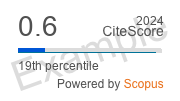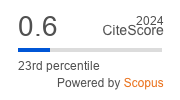Immediate and long-term echocardiographic evaluation of cardiac structures in children with obstructive hypertrophic cardiomyopathy after transaortic extended septal
https://doi.org/10.29001/2073-8552-2025-40-3-114-122
Abstract
Hypertrophic cardiomyopathy (HCM) is a genetically determined myocardial disease with a characteristic relentless progression. The manifestation of this pathology in childhood is associated with a high risk of sudden cardiac death and the development of heart failure (HF) symptoms. Transaortic extended septal myectomy (TAESM) is currently recognized as the “gold standard” for the treatment of this pathology. However, data on the outcomes of such interventions in children with obstructive HCM are very limited, which does not allow for a complete assessment of its effectiveness.
Aim: To evaluate structural and systolic-diastolic changes in the characteristics of the left heart chambers in children with obstructive HCM after TAESM in the early and long-term follow-up periods, based on echocardiography (EchoCG) data.
Material and Methods. A retrospective analysis was conducted of data from children with HCM after successful TAESM in the cardiac surgery department No. 2 of the Research Institute of Cardiology, Tomsk National Research Medical Center, from 2010 to 2024. Immediate and long-term EchoCG indicators of heart structures were evaluated.
Results. The average age of patients was 5.51 ± 2.2 years. 46 (92%) patients had symptoms of HF. Biventricular myectomy was performed in 16 (32%) cases. In the preoperative period, there was a significant gradient in the left ventricular outflow tract (LVOT) of 75.0 [57.0; 127.0] mm Hg, mitral regurgitation of varying degrees, and systolic anterior motion of the mitral valve (SAM syndrome) in all patients. After successful TAESM, a significant decrease in dynamic LVOT obstruction, structural and anatomical characteristics, and systolic and diastolic function of the left ventricle (LV) was recorded. Follow-up in the long-term period showed a decrease in the median z-score of the left ventricular posterior wall thickness from 2.6 [0.9; 5.2] to 2.0 [1.1; 3.12], the left ventricular mass index from 167.6 [55.1; 370.37] to 148.66 [34.25; 3259.1] g/m2, the TEI index from 0.95 [0.3; 1.64] to 0.65 [0.34; 1.15], p = 0.04; 0.012 and 0.024, respectively. The z-score of the left ventricular end-diastolic volume (EDV) also changed statistically significantly from –3.8 [–2.42; 5.99] to –0.07 [–1.99; 5.6], p = 0.034. The remaining indicators remained within the reference values.
Conclusion: TAESM is an effective procedure for reducing the gradient in the LVOT, eliminating SAM syndrome, and reducing mitral regurgitation in children with obstructive HCM, both in the early and long-term follow-up periods. These results are confirmed by EchoCG data, the “gold standard” of diagnosis. In addition, there is a significant decrease in left ventricular myocardial mass, the z-score of the LV posterior wall thickness, and the left atrial volume index, which may indirectly indicate reverse remodeling of the chambers after successful TAESM in children. A statistically significant decrease in the z-score of hypertrophic and restrictive cardiomyopathy after TRESM indicates the possibility of using these indicators to quantitatively assess the effectiveness of surgical intervention.
Keywords
About the Authors
R. S. KozhanovRussian Federation
Roman S. Kozhanov - Cand. Sci. (Med.), Cardiovascular Surgeon, Department of Cardiac Surgery No.2, Junior Research Scientist, Department of Cardiovascular Surgery, Cardiology Research Institute, Tomsk NRMC.
111a, Kievskaya str., Tomsk, 634012
O. A. Egunov
Russian Federation
Оleg A. Egunov - Cand. Sci. (Med.), Cardiovascular Surgeon, Department of Cardiac Surgery No.2, Research Scientist, Department of Cardiovascular Surgery, Cardiology Research Institute, Tomsk NRMC.
111a, Kievskaya str., Tomsk, 634012
N. M. Troshkinev
Russian Federation
Nikita M. Troshkinev - Cand. Sci. (Med.), Cardiovascular Surgeon, Department of Cardiac Surgery №2, Research Scientist, Department of Cardiovascular Surgery, Cardiology Research Institute, Tomsk NRMC.
111a, Kievskaya str., Tomsk, 634012
A. A. Sokolov
Russian Federation
Alexander A. Sokolov - Dr. Sci. (Med.), Professor, Head of the Department of Functional and Laboratory Diagnostics, Cardiology Research Institute, Tomsk NRMC.
111a, Kievskaya str., Tomsk, 634012
E. V. Krivoshchekov
Russian Federation
Evgeny V. Krivoshchekov - Dr. Sci. (Med.), Cardiovascular Surgeon, Head of the Cardiac Surgery Department №3, Federal Center for High Medical Technologies, Ministry of Health of the Russian Federation.
5371, Kaliningrad, 236035
References
1. Kozhanov R.S., Egunov O.A., Svyazov E.A., Krivoshchekov E.V. Historical and modern aspects of surgical treatment of hypertrophic cardiomyopathy in children (literature review). Siberian Journal of 2008;21(6):684–688.
2. Dzemeshkevich S.L., Motreva A.P., Kalachanova E.P., Nikityuk T.G., Martyanova Yu.B., Kalmykova O.V. et al. Manifestation of hypertrophic cardiomyopathy in children: phenotype, genotype and features of surgical treatment. Clinical and Experimental Surgery. Petrovsky Journal. 2021;9(3):16–24. (In Russ.). https://doi.org/10.33029/23081198-2021-9-3-16-24.
3. Kozhanov R.S., Egunov O.A., Yanulevich O.S., Sokolov A.A., Krivoshchekov E.V. Immediate results of transaortic extended septal myectomy in children with obstructive hypertrophic cardiomyopathy. Clinical and Experimental Surgery. Petrovsky Journal. 2023;11(2):93–100. (in Russ.). https://doi.org/10.33029/2308-1198-2023-11-2-93-100.
4. Arghami A., Dearani J.A., Said S.M., O'Leary W.P., Schaff H.V. Hypertrophic cardiomyopathy in children. Ann. Cardiothorac. Surg. 2017;6(4):376–385. https://doi.org/10.21037/acs.2017.07.04.
5. Menon S.C., Eidem B.W., Dearani J.A., Ommen S.R., Ackerman M.J., Miller D. Diastolic dysfunction and its histopathological correlation in obstructive hypertrophic cardiomyopathy in children and adolescents. J. Am. Soc. Echocardiogr. 2009;22(12):1327–1334. https://doi.org/10.1016/j.echo.2009.08.014.
6. Altarabsheh S.E., Dearani J.A., Burkhart H.M., Schaff H.V., Deo S.V., Eidem B.W. et al. Outcome of septal myectomy for obstructive hypertrophic cardiomyopathy in children and young adults. Ann. Thorac. Surg. 2013;95(2):663–669. https://doi.org/10.1016/j.athoracsur.2012.08.011.
7. Xu H., Yan J., Wang Q., Li D., Guo H., Li S. et al. Extended septal myectomy for hypertrophic obstructive cardiomyopathy in children and adolescents. Pediatr. Cardiol. 2016;37(6):1091–1097. https://doi.org/10.1007/s00246-016-1396-5.
8. Jefferies J.L., Wilkinson J.D., Sleeper L.A., Colan S.D., Lu M., Pahl E. et al. Cardiomyopathy phenotypes and outcomes for children with left ventricular myocardial noncompaction: Results from the Pediatric Cardiomyopathy Registry. J. Card. Fail. 2015;21(11):877–884. https://doi.org/10.1016%2Fj.cardfail.2015.06.381.
9. Chubb H., Simpson J.M. The use of Z-scores in paediatric cardiology. Ann. Pediatr. Cardiol. 2012;5(2):179–184. https://doi.org/10.4103/09742069.99622.
10. Kozhanov R.S., Egunov О.A., Naumov S.S., Vtorushin S.V., Krivoshchekov E.V. The role of transaortic extended septal myectomy in children with Noonan syndrome and obstructive hypertrophic cardiomyopathy. Clinical and Experimental. Surgery. Petrovsky Journal. 2024;12(1):30–39. (In Russ.). https://doi.org/10.33029/2308-1198-202412-1-30-39.
11. Elliott P.M., Anastasakis A., Borger M.A., Borggrefe M., Cecchi F., Charron P. et al. 2014 ESC guidelines on diagnosis and management of hypertrophic cardiomyopathy. Eur. Heart J. 2014;35(39):1054–1126. https://doi.org/10.1093/eurheartj/ehu284.
12. Dearani J.A., Ommen S.R., Gersh B.J., Schaff H.V., Danielson G.K. Surgery insight: Septal myectomy for obstructive hypertrophic cardiomyopathy – the Mayo Clinic experience. Nat. Clin. Pract. Cardiovasc. Med. 2007;4(9):503–512. https://doi.org/10.1038/ncpcardio0965.
13. Ingles J., Goldstein J., Thaxton C., Caleshu C., Corty E.W., Crowley S.B. et al. Evaluating the clinical validity of hypertrophic cardiomyopathy genes. Circ. Genom. Precis. Med. 2019;12(2):e002460. https://doi.org/10.1161/circgen.119.002460.
14. Menon S.C., Ackerman M.J., Ommen S.R., Cabalka A.K., Hagler D.J., O’Leary P.W. et al. Impact of septal myectomy on left atrial volume and left ventricular diastolic filling patterns: An echocardiographic study of young patients with obstructive hypertrophic cardiomyopathy. J. Am. Soc. Echocardiogr. 2008;21(6):684–688. https://doi.org/10.1016/j.echo.2007.11.006.
15. Hiemstra Y.L., Debonnaire P., Bootsma M., Van Zwet E.W., Delgado V., Schalij M.J. et al. Global longitudinal strain and left atrial volume index provide incremental prognostic value in patients with hypertrophic cardiomyopathy. Circ. Cardiovasc. Imaging. 2017;10(7):e005706. https://doi.org/10.1161/circimaging.116.005706.
16. Deb S.J., Schaff H.V., Dearani J.A., Nishimura R.A., Ommen S.R. Septal myectomy results in regression of left ventricular hypertrophy in patients with hypertrophic obstructive cardiomyopathy. Ann. Thorac. Surg. 2004;78(6):2118–2122. https://doi.org/10.1016/j.athoracsur.2004.05.063.
17. Mejia A.S., Simpson E.K., Hildebolt C.F., Pahl E., Matthews K.L., Rainey C.A. et al. Tissue dopplerseptal tei index indicatesseverity of illness in pediatric patients with congestive heart failure. Pediatr. Cardiol. 2014;35(3):411–418. https://doi.org/10.1007/s00246-013-0794-1.
18. Bruch C., Schmermund A., Dagres N., Katz M., Bartel T., Erbel R. Tei-index in symptomatic patients with primary and secondary mitral regurgitation. Int. J. Cardiovasc. Imaging. 2002;18(2):101–110. https://doi.org/10.1023/a:1014664418322.
19. Kubo T., Gimeno J.R., Bahl A., Steffensen U., Steffensen M., Osman E., et al. Prevalence, clinical significance, and genetic basis of hypertrophic cardiomyopathy with restrictive phenotype. J Am Coll Cardiol. 2007;49(25):2419–2426. https://doi.org/10.1016/j.jacc.2007.02.061.
20. Sokolov A.A., Smorgon A.V., Kozhanov R.M., Krivoshchekov E.V. Quantitative characteristics of cardiomyopathy phenotypes in children and adults by the value of deviation from the norm of echocardiographic parameters. Siberian Journal of Clinical and Experimental Medicine. 2023;38(3):163–171. (In Russ.). https://doi.org/10.29001/2073-85522023-39-3-163-171.
Review
For citations:
Kozhanov R.S., Egunov O.A., Troshkinev N.M., Sokolov A.A., Krivoshchekov E.V. Immediate and long-term echocardiographic evaluation of cardiac structures in children with obstructive hypertrophic cardiomyopathy after transaortic extended septal. Siberian Journal of Clinical and Experimental Medicine. 2025;40(3):114-122. (In Russ.) https://doi.org/10.29001/2073-8552-2025-40-3-114-122





.png)





























